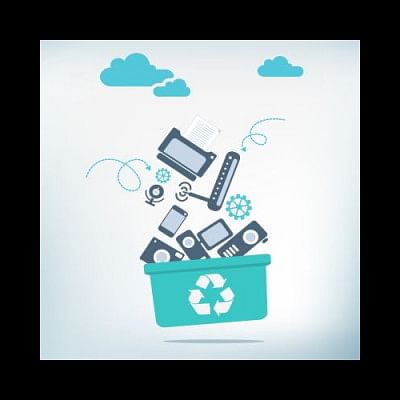Where do we dump our e-waste?

Bangladesh lacks an e-waste (electronic waste) disposal policy. Urbanisation has brought forth rapid population growth of major urban centres like Dhaka. Our fast-paced lifestyle has ushered in both consumerism and adoption of technology on a mass scale, and that is to be expected. It is also expected that as we embrace consumerism and as our incomes rise, people will want better, faster devices like the latest phones and computers, more energy efficient household appliances - refrigerators, light bulbs and more feature rich devices like televisions and home audio systems. What we do not think about when we discard older devices is where they end up or what they do to the environment. E-waste is a growing problem that needs to be managed properly. According to media reports, we were producing approximately 500 tonnes of e-waste two years ago, and this trend has grown steadily. It is not merely a lack of policy but also a lack of awareness amongst people as to how we dump our discarded appliances.
The challenge before us is that discarding such e-waste and their ending up in landfills are a major health hazard. Indeed, we have no reliable data on precisely what type of equipment is being discarded on an annual basis. As per a report in a leading Bangla daily recently, research conducted by various bodies pose a glum picture. One research carried out in 2012 pits the number of TV stations in the country at 20 million and according to Bangladesh Electrical Merchandise Manufacturers' Association, Bangladeshis use electronic gadgets worth Tk. 30,000 crores. BTRC estimates that there are an estimated 130 million mobile phone connections and most alarming (according to Bangladesh Computer Society data); nearly 30 percent of used desktops, laptops, and tablets become unusable after the first year of use.
Precise data on the amount of e-waste is missing but according to non-government sources, the amount has crossed 100,000 tonnes a year annually. E-waste cannot be treated the same as other waste because they contain harmful substances like mercury and other toxic elements like silicon, tin, resin, cadmium, zinc, chromium, etc. which permeate soil and pose a major risk to the food chain. While there is a growing business in electronic recycling, the sheer volume of waste being generated and our failure to either recycle on a mass scale or dispose of them safely pose serious health hazards.
Managing e-waste requires a tripartite approach; new government policy and management authority, educating the population on safe disposal and bringing together manufacturers and importers of electronic appliances to take responsibility for environmental pollution. It is interesting to note that the Department of Environment (DoE) formulated a policy in 2012 that obligates Electronic Equipment producer to take responsibility of e-waste management and cost of e-waste. We can introduce measures like Extended Producer Responsibility (EPR) policy. This policy approach requires, producers, importers, or brand owners of electronic equipment pay a fee to ensure proper disposal and/or recycling of the product after it reaches its end of productive life. The Annual Recycling Fee (ARF) to be paid by consumers in the same manner they pay VAT when procuring an electronic item; this fee too goes to a fund that ensures that the product is properly recycled. We have a growing informal sector dedicated to recycling in Dhaka city. But one of the problems we face in greater recycling opportunities is that consumers do not realise the importance of segregating normal waste from e-waste.
Educating city residents remains a key element if we want to be serious about e-waste management. The primary sorting of electronic and non-electronic garbage begins at the household level and it goes far beyond simply providing different coloured bins. The problem can be highlighted from the experience of the Bangladesh Climate Change Trust Fund that expended Tk. 2.1 million to give residential buildings in various parts of the city waste bins in four different colours (green, yellow, red and blue). The idea was that cleaners working in these buildings would divide up the waste in four categories: organic, inorganic, hazardous and mixed and put them into the four different bins allotted. That project didn't go far because cleaners didn't feel the need to see it through and therein lay the problem. Unless people in general are made aware of the hazards posed by e-waste, particularly the health hazards that affect them directly, innovative initiatives like this one will end in failure.
At the end of the day, e-waste will end up in landfills and while prudent government policy initiatives should engage importers, manufacturers and consumers to do their part; it should start looking seriously into landfill gas extraction-to-power generation technologies and partner with multinational companies that have a proven track record of transforming methane into electricity. Successful examples exist in Asia. For instance, China remains one of the world's greatest polluters and e-waste remains a major headache for policymakers as the country has more than 5,000 landfills. China's Shanghai Laogang (a joint Chinese-foreign collaboration), one of Asia's largest landfill-to-gas plants, started producing electricity in 2008 and the plant that operates 11 sets of gas engines produced some 24,000 megawatts (MWh) of electricity in 2012 alone. Since it went into operation, the plant has also treated approximately 58 million cubic meters of landfill gas that resulted in generating 73,000 MWh of power. The examples of successful e-waste management are out there; the question is will our policymakers take heed?
The writer is Assistant Editor, The Daily Star.

 For all latest news, follow The Daily Star's Google News channel.
For all latest news, follow The Daily Star's Google News channel. 



Comments